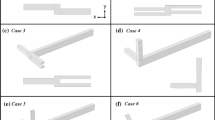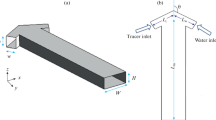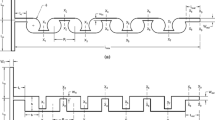Abstract
The study of steady and unsteady microflows plays an important role in micromixing applications. In this paper, Computational Fluid Dynamics (CFD) simulations using OpenFOAM have been carried out to investigate mixing efficiency and flow characteristics with rectangular geometry of three different wall conditions. The geometries of the microchannels were rectangular with the dimensions of 4000 μ length, 1000 μ depth and 1000 μ width. The first channel does not have a hydro-active patch along the length of the channel. In the second channel, hydro-active patches of 1000 μ are placed symmetrically on the top and bottom along the length of the microchannel. In the third channel, hydro-active patches of 1000 μ are placed asymmetrically on the top and bottom along the length of the microchannel. A three-dimensional (3D) model was created for three geometries and simulations were performed to investigate the mixing effect for mixing two different fluids. The developed mathematical model was based on modified wall surface boundary conditions with an unsteady state of the flow field. The effect of introducing hydro-active patches in the form of symmetric boundary conditions led to a reduction in micromixer length approximately by a factor of three. The enhancement in the mixing efficiency in shorter lengths is due to surface modification, which significantly affects the unsteady behaviour of the flow field. In symmetric and asymmetric geometries with hydro-active patches, swirling vortexes were developed providing good mixing results.











Similar content being viewed by others
References
M Matrinelli, M Nimafar and V Viktorov, Majlesi J. Mechatron. Syst. 1, 20 (2012)
A Shinde, Sverian Sci. 1, 1 (2015)
J H Tsui, W Lee, S H Pun, J Kim and D H Kim, Adv. Drug Deliv. Rev. 65, 1575 (2013)
S J Park, J K Kim, J Park, S Chung, C Chung and J K Chang, J. Micromech. Microeng. 14, 6 (2003)
V Viktorov, C Visconte and M R Mahmud, J. Fluids Eng. Trans. 138, 1 (2016)
V Rudyak and A Minakov, Micromachines 5, 886 (2014)
G P Zhu and N T Nguyen, Lab Chip. 12, 4772 (2012)
V Viktorov and M Nimafar, J. Micromech. Microeng. 23, 55023 (2013)
H Le The, B Q Ta, H Le Thanh, T Dong, T N Thoi and F Karlsen, J. Micromech. Microeng. 25, 094004 (2015)
L Balasubramaniam, R Arayanarakool, S D Marshall, Li, P S Lee and P C Y Chen, J. Micromech. Microeng. 27, 95016 (2017)
C Saikat, M Sharath, M Srujana, K Narayan and P K Pattnaik, AIP Conf. Proc. 1715, 020013 (2016)
M K Parsa and F Hormozi, J. Micromech. Microeng. 24, 065018 (2014)
C Te Lee and C C Lee, J. Micromech. Microeng. 22, 105034 (2012)
S Naher, D Orpen, D Brabazon, C R Poulsen and M M Morshed, Simul. Model. Pract. Theory 19, 1088 (2011)
M G Reddy, M S Rani, K G Kumar, B C Prasannakumar and H J Lokesh, Phys. A: Stat. Mech. Appl. 551, 123975 (2020)
K Ganesh Kumar, Eur. Phys. J. Plus 137, 669 (2022)
K G Kumar, E H B Hani, M Assad, M Rahimi-Gorji and S Nadeem, Microsyst. Technol. 27, 97 (2021)
K Kumar, M Reddy, M Gnaneswara, P Vijaya Kumari, P Aldalbahi A Rahimi-Gorji, M Rahaman, Chaos Solitons Fractals 141, 110350 (2020)
M Gnaneswara Reddy, K Ganesh Kumar and S Shehzad, Phys. Scr. 95, 125201 (2020)
M G Reddy, N Kumar, B C Prasannakumara, N G Rudraswamy and K G Kumar, Commun. Theor. Phys. 73, 045002 (2021)
S K Ranjith, B S V Patnaik and S Vedantam, Soft Matter 10, 4184 (2014)
J Kim, I Hwang, D Britain, T D Chung, Y Sun and D H Kim, Lab Chip. 11, 3941 (2011)
I O De Solorzano, L Uson, A Larrea, M Miana, V Sebastian and M Arruebo, Int. J. Nanomed. 11, 3397 (2016)
S Togashi, E Katayama and M Matsuzawa, Int. J. Chem. Eng. 7, 489 (2013)
H Wu, C Wang, C Zeng and L Zhang, Ind. Eng. Chem. Res. 52, 5313 (2013)
H Hadidi and R Kamali, J. Micromech. Microeng. 26, 35019 (2016)
J Jamaati, H Niazmand and M Renksizbulut, JCARME 3, 41 (2013).
F Huchet, P Legentilhomme, J Legrand, A Montillet and J Comiti, Exp. Fluids 51, 597 (2011)
J H E Cartwright, M Feingold and O Piro, J. Fluid Mech. 316, 259 (1996)
S Contreras and M Speetjens, 71st Annu. Meet. APS Div. Fluid Dyn. 63, 13 (2018)
M Bedau, Weak emergence philosophical perspectives, in: Mind, causation and world (Wiley-Blackwell, 1997) Vol. 11, pp. 375–399
P Hovda, Minds Mach. 18, 461 (2008)
H Thoren and P Gerlee, Weak emergence and complexity (MIT Press, Denmark, 2010) pp. 879–886
Y Liu, K Pekkan, S C Jones and A P Yoganathan, J. Biomech. Eng. 126, 594 (2004)
L Capretto, W Cheng and M Hill, Top. Curr. Chem. 304, 27 (2011)
J M Ottino, The kinematics of mixing: Stretching, chaos, and transport (The Press Sindicate of the University of Cambridge, 1989) pp. 1–3, 227–237
P J Roache, Fundamentals of computational fluid dynamics (Hermosa Publishers, 1998)
I B Celik, U Ghia, P J Roache, C J Freitas, H Coleman and P E Raad, J. Fluids Eng. Trans. 130, 0780011 (2008)
M Dhlamini, H Mondal and P Sibanda, Pramana – J. Phys. 96, 112 (2022)
J Coleman, M McKechnie and D Sinton, Lab Chip. 6, 1033 (2006)
F Yang, W Zhao and G Wang, Chin. J. Chem. Eng. 42, 256 (2022)
Author information
Authors and Affiliations
Corresponding author
Rights and permissions
Springer Nature or its licensor (e.g. a society or other partner) holds exclusive rights to this article under a publishing agreement with the author(s) or other rightsholder(s); author self-archiving of the accepted manuscript version of this article is solely governed by the terms of such publishing agreement and applicable law.
About this article
Cite this article
Amritkar, M., Patil, A., Barve, S. et al. Simulation study on the effect of hydro-active patches in passive micromixer geometry for fluid flow and mixing. Pramana - J Phys 98, 15 (2024). https://doi.org/10.1007/s12043-023-02680-4
Received:
Revised:
Accepted:
Published:
DOI: https://doi.org/10.1007/s12043-023-02680-4




